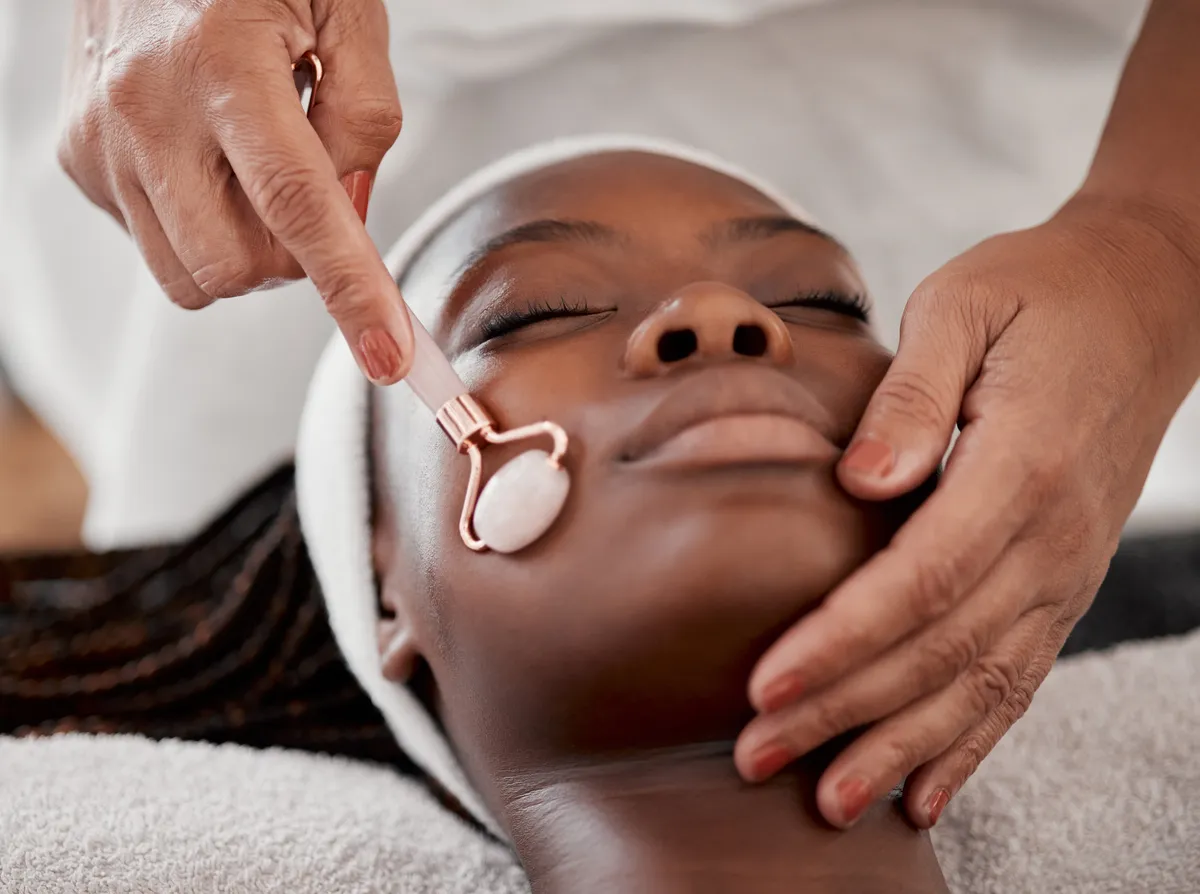Skin Discoloration Explained: The Difference Between Melasma and Sun Spots
Noticing a new patch or spot on your skin can leave you wondering: Is it just a sun spot, or could it be something more, like melasma? Both conditions are common forms of skin discoloration, but they develop for different reasons and require different approaches to care. Whether it’s hormonal changes or sun exposure to blame, understanding the differences between melasma and sun spots is the first step toward finding the right solution.
In this article, we’ll break down what sets these two types of discoloration apart, how they show up on your skin, and what you can do to prevent and treat them.
What is Melasma?
Melasma is a chronic skin condition that causes brown or grayish-brown patches, usually on the face. It’s common on the forehead, cheeks, upper lip, and sometimes forearms. Known as the “pregnancy mask,” melasma often appears due to hormonal changes during pregnancy or from birth control use.
What Causes Melasma?
The exact cause of melasma isn’t fully understood, but common factors include:
- Hormonal changes (pregnancy, birth control, menopause)
- Sun exposure triggering excess melanin production
- Genetics – it’s more likely if others in your family have it
Triggers to Watch For
Certain things can make melasma worse, such as:
- UV rays – even minimal sun exposure can darken patches
- Heat – warm weather or saunas may intensify symptoms
- Hormonal shifts – pregnancy, menopause, or hormone therapy
Though melasma isn’t harmful, it can be persistent. Proper sun protection and professional treatment can help manage it effectively.
What are Sun Spots?
Sun spots, also called age spots or liver spots, are flat, brown spots that develop from prolonged exposure to ultraviolet (UV) light. Unlike melasma, sun spots are directly caused by cumulative sun exposure over time, including tanning beds. They’re especially common in areas that receive the most sun, like the face, hands, shoulders, arms, and back.

What Causes Sun Spots?
Sun spots form after years of exposure to UV rays, which cause melanin (the pigment responsible for skin color) to build up in certain areas. The most common causes include:
- Cumulative sun exposure from outdoor activities or sunbathing
- Use of tanning beds, which accelerate UV damage
When Do Sun Spots Appear?
Sun spots typically start showing up later in life, usually in your 30s or 40s, though they may appear earlier with frequent sun exposure. While they aren’t dangerous, many people seek treatments to reduce their appearance for cosmetic reasons.
Differences Between Melasma and Sun Spots
Though melasma and sun spots both cause discoloration, they differ in appearance, causes, and how they respond to treatment. Knowing these distinctions can help you identify the issue and find the most effective solution.
Color and Shape
Melasma appears as irregular, patchy areas with grayish or brown tones that blend into the skin. In contrast, sun spots are round, flat, and darker brown, making them more distinct.
Location on the Skin
Melasma typically forms on the forehead, cheeks, upper lip, and sometimes on the forearms. Sun spots, however, show up on areas frequently exposed to the sun, such as the hands, shoulders, and back.
Persistence and Treatment
Melasma tends to be more challenging to treat, often returning even after fading. It requires a combination of lifestyle changes and professional treatments to manage. Sun spots, on the other hand, respond well to treatments like laser therapy or chemical peels and are less likely to reappear once treated.
Treatment Options for Melasma
Treating melasma requires a multi-faceted approach, as the condition can be persistent and prone to returning. While no single solution works for everyone, a combination of topical treatments, cosmetic procedures, and lifestyle changes can help manage symptoms effectively.
Topical Treatments
At Pure Dermatology, we often recommend topical creams to lighten melasma patches over time. Common options include hydroquinone, tretinoin with corticosteroids, and azelaic acid or kojic acid, which work to reduce pigmentation gradually.
Cosmetic Procedures
For more stubborn cases, cosmetic treatments can be effective, but they should always be performed under the supervision of a dermatologist. Chemical peels can help exfoliate the skin and promote even tone, while laser therapies like Fraxel can target deep pigmentation. However, caution is needed—some lasers may worsen pigmentation if not used correctly.
Lifestyle Changes
Daily habits play a crucial role in managing melasma. Wearing a broad-spectrum SPF sunscreen every day, even when it’s cloudy, is essential to prevent flare-ups. Incorporating sun-protective clothing, like wide-brimmed hats and sunglasses, can further reduce exposure. Avoiding heat, including saunas and hot yoga, can also help minimize symptoms.
By combining these treatments and preventive strategies, many people see significant improvement in their skin’s appearance. Regular check-ins with a dermatologist ensure the best results over time.

Treatment Options for Sun Spots
Sun spots, though harmless, can be a cosmetic concern for many people. Fortunately, several treatments are available to lighten or remove these spots, ranging from topical solutions to in-office procedures.
Topical Treatments
Topical products can help fade sun spots gradually over time. Retinoids speed up cell turnover, promoting new, even-toned skin. Vitamin C serums are another popular choice, helping to brighten the skin and reduce pigmentation.
Cosmetic Procedures
For more immediate results, dermatologists may recommend cosmetic procedures. Laser treatments, such as IPL or Fraxel, can target pigmented areas, breaking down melanin. Cryotherapy uses freezing to remove stubborn spots, while chemical peels exfoliate the skin, encouraging new, healthier skin to surface.
At-Home Options
For those who prefer at-home care, brightening serums and over-the-counter exfoliants can help reduce the appearance of sun spots. While results may take longer, a consistent skincare routine can lead to gradual improvement.
Whether you opt for topical products, cosmetic treatments, or at-home care, consistency is key. Consulting with a dermatologist will ensure you choose the best approach for your skin type and goals.

Prevention Strategies for Both Conditions
While melasma and sun spots develop for different reasons, prevention plays a key role in managing both. Protecting your skin from UV exposure and incorporating smart skincare habits can reduce the likelihood of new discoloration appearing.
How to Prevent Melasma
Melasma is particularly sensitive to both sunlight and heat, making daily protection essential.
- Limit sun exposure, especially during peak UV hours (10 a.m. to 4 p.m.).
- Use mineral-based sunscreen containing zinc oxide or titanium dioxide, as these ingredients offer broad-spectrum protection.
- Wear physical blockers like wide-brimmed hats and sunglasses to shield your skin from direct sunlight.
- Stay cool by avoiding heat triggers such as saunas and hot yoga, which can aggravate melasma.
How to Prevent Sun Spots
Since sun spots result from cumulative UV exposure, protecting your skin daily can prevent them from forming.
- Apply sunscreen every day, even when it’s cloudy or during winter.
- Avoid tanning beds, which accelerate UV damage and lead to sun spots.
- Incorporate antioxidants like vitamin C into your skincare routine to neutralize free radicals and protect your skin from sun damage.
Developing these habits can make a noticeable difference over time, helping you maintain a clear, even complexion. Pure Dermatology offers a range of SPF products and antioxidants to support your prevention efforts—explore the shop to find the right solutions for your skin.
When to See a Dermatologist and How Pure Dermatology Can Help
If you notice sudden dark patches or if your discoloration worsens despite using sunscreen, it may be time to consult with a dermatologist. Professional care ensures that you receive an accurate diagnosis and explore the most effective treatment options for your skin type.
At Pure Dermatology, our team specializes in diagnosing and treating skin discoloration, including melasma and sun spots. We offer a range of treatments—from chemical peels to laser therapy—and create customized skincare routines to help you achieve lasting results. Whether you need guidance on managing melasma or solutions to fade sun spots, we’re here to help you regain confidence in your skin.
Book a consultation today and take the first step toward a clearer, more even complexion


